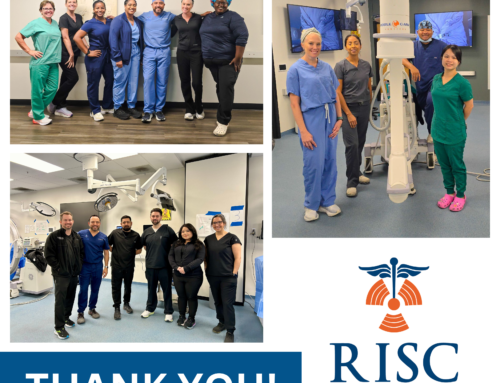Radiation Safety in Medical Imaging
The Double-Edged Sword of Radiation in Medical Imaging
Radiation safety in medical imaging is a top priority in the industry today. Radiation has transformed the landscape of medical imaging, making it possible for healthcare professionals to see inside the human body with unprecedented clarity. Techniques such as X-rays, computed tomography (CT), and nuclear medicine have become essential tools in diagnosing and treating various medical conditions. However, with this powerful technology comes significant responsibility. While radiation plays a vital role in modern medicine, improper use and inadequate safety measures can pose serious health risks to both patients and healthcare providers.
The balancing act between leveraging the benefits of radiation and ensuring safety is crucial. Let’s talk about the critical aspects of radiation safety, focusing on the role of dosimeters, the ALARA principle, and the potential side effects of radiation exposure when safety protocols are ignored. By understanding these elements, healthcare providers can prioritize safety and protect both themselves and their patients.
Understanding Radiation Exposure: The Science and Risks
What is Radiation?
Radiation refers to the emission of energy as electromagnetic waves or subatomic particles. In the context of medical imaging, we primarily deal with ionizing radiation, which has enough energy to remove tightly bound electrons from atoms, thereby creating ions. This type of radiation can be highly effective in producing images of internal body structures but also carries inherent risks.
Types of Radiation in Medical Imaging
- X-rays: X-rays are a form of electromagnetic radiation commonly used in diagnostic imaging. They penetrate body tissues to varying degrees, allowing for the creation of images that highlight differences in tissue density. The use of X-rays has been instrumental in diagnosing fractures, infections, and tumors.
- Computed Tomography (CT): CT scans utilize X-rays and advanced computer algorithms to produce detailed cross-sectional images of the body. While CT scans provide invaluable diagnostic information, they expose patients to higher doses of radiation than standard X-rays. The rapid acquisition of images in a short time frame can increase the risk of radiation exposure, making it essential to adhere to safety protocols.
- Nuclear Medicine: This involves the use of small amounts of radioactive materials, called radiotracers, which are administered to patients. The radiotracers emit gamma rays that are detected by special cameras, allowing healthcare professionals to visualize organ function and detect abnormalities. Nuclear medicine techniques, such as PET scans, are invaluable for diagnosing conditions like cancer and heart disease.
How Radiation Works in Medical Imaging
In medical imaging, radiation is directed at the body, and as it passes through tissues, it is absorbed at different rates. Denser tissues, such as bones, absorb more radiation and appear white on the image, while less dense tissues, like muscles and organs, absorb less radiation and appear in varying shades of gray. This contrast allows healthcare providers to diagnose conditions such as fractures, tumors, and infections.
The effectiveness of imaging techniques often relies on the ability to differentiate between various types of tissues. For instance, in mammography, soft tissue and dense breast tissue can be distinguished, aiding in the early detection of breast cancer.
Risks Associated with Radiation Exposure
While radiation is a powerful tool, it is not without risks. Understanding these risks is essential for ensuring patient and provider safety.
Short-Term vs. Long-Term Risks
- Acute Effects: In situations involving high doses of radiation, such as radiation therapy or accidental exposure, immediate effects can occur. These may include skin burns, radiation sickness, and other acute health issues. However, such scenarios are rare in diagnostic radiology, where exposure levels are generally kept within safe limits.
- Long-Term Effects: Prolonged exposure to ionizing radiation, even at low levels, can increase the risk of cancer and other long-term health issues. The risk is cumulative, meaning that repeated exposures can significantly raise the likelihood of adverse outcomes. Research has shown that even low doses of radiation can lead to DNA damage, which may result in mutations and, over time, cancer. The linear no-threshold model (LNTH) suggests that even small doses of radiation have the potential to increase cancer risk.
Vulnerable Populations
Certain populations are more susceptible to the effects of radiation. Children, for instance, are at a higher risk due to their developing tissues and longer life expectancy, allowing more time for potential radiation-induced damage to manifest. Pregnant women also require special consideration, as radiation exposure can harm the developing fetus.
Studies have shown that children are more sensitive to radiation than adults, with estimates indicating that they may be five to ten times more likely to develop cancer from the same dose of radiation. Therefore, healthcare providers must carefully weigh the necessity of imaging procedures for pediatric patients and explore alternative options when appropriate.
Dosimeters: The Guardians of Safety
Dosimeters play a crucial role in radiation safety, particularly for healthcare professionals who work with or around ionizing radiation. These devices monitor radiation exposure and help ensure that safety protocols are followed.
What are Dosimeters?
A dosimeter is a device used to measure an individual’s exposure to ionizing radiation over time. By providing accurate data on exposure levels, dosimeters help healthcare professionals maintain safety standards and comply with regulatory requirements.
Dosimeters are essential tools for monitoring radiation exposure in various settings, including hospitals, research facilities, and industrial environments where radiation is present. They provide a way to quantify exposure and ensure that it remains within acceptable limits.
Types of Dosimeters
There are several types of dosimeters commonly used in healthcare settings, each with its own advantages and limitations:
- Film Badge Dosimeters: One of the oldest types, these consist of a small piece of photographic film encased in a badge. The film darkens in response to radiation, with the degree of darkening indicating the level of exposure. While effective, film badges are typically read only after a set period, limiting real-time monitoring. They are primarily used for personnel monitoring and can provide a historical record of exposure.
- Thermoluminescent Dosimeters (TLDs): TLDs use crystalline materials that absorb and store energy from radiation exposure. When heated, the crystals release the stored energy as light, which is measured to determine exposure levels. TLDs are often used for their accuracy and can be read multiple times. They are commonly used in clinical settings and research, as they can provide detailed exposure data.
- Electronic Personal Dosimeters (EPDs): EPDs are digital devices that provide real-time monitoring of radiation exposure. These dosimeters can be programmed to alert users when exposure levels exceed predefined thresholds, making them a valuable tool for immediate feedback on safety. EPDs are increasingly popular in healthcare settings due to their convenience and the ability to provide instant information about exposure levels.
Why Dosimeters Matter
Regulatory Compliance
Many countries have established regulations regarding radiation exposure limits for healthcare workers. Dosimeters are essential for monitoring and documenting exposure levels, helping facilities comply with these regulations. By ensuring that workers stay within safe limits, dosimeters contribute to overall workplace safety.
Regular audits and checks of dosimeter readings help organizations identify trends and areas that require attention. If a healthcare professional’s exposure consistently approaches the limit, additional training or modifications to work practices may be necessary.
Personal Safety
For radiologists, technicians, and other healthcare professionals, dosimeters serve as a vital line of defense against the invisible threat of radiation. Regular monitoring allows individuals to identify unusual exposure patterns, enabling them to take corrective actions when necessary. This proactive approach is crucial in preventing long-term health issues related to radiation exposure.
Healthcare facilities often provide training to staff on how to interpret dosimeter readings and understand the implications of their exposure. Empowering workers with knowledge about their radiation exposure promotes a culture of safety and accountability.
ALARA: The Gold Standard of Radiation Safety
The ALARA principle, which stands for “As Low As Reasonably Achievable,” is a cornerstone of radiation safety in healthcare settings. It emphasizes that every effort should be made to minimize radiation exposure while still achieving the necessary diagnostic quality.
Understanding ALARA
The ALARA principle acknowledges that while some level of radiation exposure is unavoidable in medical imaging, it is essential to keep that exposure as low as reasonably achievable. This principle is not only a regulatory requirement but also a moral obligation to protect patients and healthcare workers.
The ALARA philosophy extends beyond just minimizing exposure; it also involves optimizing imaging protocols and techniques to ensure that patients receive the best possible care with the lowest risk. This may include the use of advanced imaging technology that allows for lower doses of radiation while maintaining image quality.
Implementing ALARA in Clinical Practice
To effectively implement ALARA, healthcare facilities must adopt several practical strategies:
- Optimizing Equipment Settings: Radiology equipment should be regularly calibrated and optimized to deliver the lowest possible dose while maintaining image quality. This may involve using advanced imaging techniques that reduce exposure or adjusting parameters such as exposure time and radiation dose. For example, using digital radiography instead of traditional film-based systems can significantly reduce the amount of radiation needed for imaging.
- Routine Training and Education: Ongoing training for healthcare professionals is critical to ensure they understand radiation safety protocols and the importance of ALARA. Regular refresher courses can help staff stay updated on best practices and new technologies that enhance safety. Additionally, providing resources such as online modules or workshops can further reinforce the principles of radiation safety.
- Continuous Monitoring: Regular audits and monitoring of radiation doses can help facilities identify trends and areas for improvement. By reviewing dosimeter data and analyzing exposure patterns, healthcare providers can make informed decisions about safety protocols and training. This proactive approach ensures that any potential issues are addressed before they escalate.
- Patient Education: Educating patients about the benefits and risks of imaging procedures can help them make informed decisions. Encouraging patients to ask questions and express concerns fosters a culture of safety and transparency. Healthcare providers should communicate clearly about the necessity of imaging studies, potential alternatives, and the steps taken to minimize radiation exposure.
- Utilizing Advanced Imaging Techniques: Advances in imaging technology have led to the development of techniques that minimize radiation exposure. For instance, using low-dose protocols in CT scans can significantly reduce radiation levels while still providing high-quality images. Staying abreast of these innovations and integrating them into clinical practice is vital for maintaining the ALARA principle.
The Consequences of Ignoring Radiation Safety
Neglecting radiation safety protocols can have severe consequences for both patients and healthcare workers. Understanding these risks is essential for maintaining a culture of safety in healthcare settings.
Potential Side Effects for Patients
When radiation safety measures are ignored, patients may face various side effects:
- Increased Cancer Risk: While the risk of developing cancer from a single imaging procedure is generally low, cumulative exposure from multiple procedures can significantly increase the likelihood of cancer over time. It is essential for healthcare providers to evaluate the necessity of each imaging study and consider alternative options when appropriate. Research has shown that even a single high-dose procedure can elevate the risk of radiation-induced malignancies, especially in vulnerable populations like children and adolescents.
- Radiation Burns: In high-dose procedures, particularly in interventional radiology, patients may experience radiation burns. These burns can range from mild redness to severe tissue damage, underscoring the need for careful dose management. The consequences of radiation burns can lead to prolonged recovery times and additional medical interventions, impacting the overall patient experience.
- Psychological Impact: Patients may also experience anxiety related to radiation exposure, particularly if they are not adequately informed about the risks and benefits of imaging procedures. Open communication between healthcare providers and patients is crucial in addressing these concerns. Patients may feel more at ease when they understand the measures taken to minimize their exposure and the rationale behind the imaging studies.
- Overdiagnosis and Overtreatment: The availability of advanced imaging technologies may lead to overdiagnosis, where incidental findings prompt unnecessary follow-up procedures or treatments. This not only increases the patient’s exposure to radiation but can also result in physical and emotional stress. Healthcare providers must remain vigilant in assessing the necessity of imaging studies and interpreting results within the broader clinical context.
Risks for Healthcare Workers
Healthcare workers face several potential risks when radiation safety protocols are not followed:
- Chronic Health Issues: Prolonged exposure to ionizing radiation can lead to various chronic health issues, including cataracts, skin damage, and an increased risk of cancer. The cumulative nature of radiation exposure means that even low levels can have long-term consequences. Studies have shown that healthcare workers in radiology, oncology, and nuclear medicine are at increased risk for certain types of cancers, highlighting the need for strict adherence to safety protocols.
- Professional Liability: Failing to adhere to radiation safety measures can result in legal consequences for healthcare providers. Inadequate safety protocols may expose facilities to lawsuits and damage their reputation. Ensuring that all staff members are trained and compliant with safety measures is vital in mitigating potential liabilities.
- Occupational Burnout: The stress of working in an environment where safety measures are not prioritized can contribute to burnout among healthcare workers. The awareness of potential health risks associated with radiation exposure can lead to anxiety and job dissatisfaction. Fostering a culture of safety not only protects employees but also enhances morale and job satisfaction.
- Reputation of the Facility: Facilities that fail to prioritize radiation safety may face reputational damage within the community and among healthcare professionals. Public awareness of radiation risks is growing, and patients are increasingly concerned about their safety. A commitment to safety not only protects patients and staff but also enhances the credibility of the healthcare institution.
Prioritizing Safety in Radiology
Radiation is an indispensable tool in modern medicine, providing critical diagnostic information and treatment options. However, it is crucial to recognize the associated risks and prioritize safety in all aspects of radiology practice. By utilizing dosimeters, adhering to the ALARA principle, and fostering a culture of safety, healthcare providers can protect both their patients and themselves from the potential hazards of radiation.
As we continue to embrace the advancements in medical imaging technology, a commitment to safety must remain at the forefront of our practices. By investing in ongoing education, employing innovative techniques, and prioritizing communication with patients, healthcare providers can mitigate risks and ensure that the benefits of radiation in medical imaging are realized without compromising safety.
In the ever-evolving field of medical imaging, it is our collective responsibility to stay informed, adhere to best practices, and continuously strive for excellence in patient care while safeguarding our health and that of our colleagues. Ultimately, radiation safety is not just a regulatory requirement; it is a fundamental ethical obligation that underscores our commitment to patient-centered care.






